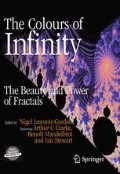Abstract
The authors begin by modelling the World Wide Web as an ecosystem, which reflects an intimate coupling of people, programs, and pages. Viewing the Web from a variety of scales and viewpoints, from macroscopic to microcscopic, it is evident that users, authors, and search engines all influence one another to yield an amazing array of self-organization, self-regulation, and self-similarity. Ultimately, the Web’s organization is intimately related to the complexity of human culture and to the human mind, and it is this subtle relationship between humanity and the Web that is responsible for the Web’s amazing properties.
Access this chapter
Tax calculation will be finalised at checkout
Purchases are for personal use only
References
Albert-Lászlo Barabási and Réka Albert. Emergence of scaling in random networks. Science, 286: 509–512, 1999.
Sergey Brin and Lawrence Page. The Anatomy of a Large-Scale Hypertextual Web Search Engine. Proceedings of the 7th World Wide Web Conference (WWW7), 1998.
Andrei Broder, Ravi Kumar, Farzin Maghoul, Prabhakar Raghavan, Sridhar Rajagopalan, Raymie Stata, Andrew Tomkins, and Janet Wiener. Graph structure in the web: Experiments and models. Proceedings of The 9th World Wide Web Conference (WWW9), 2000.
Soumen Chakrabarti, Mukul M. Joshi, Kunal Punera, and David M. Pennock. The structure of broad topics on the Web. Proceedings of The 11th World Wide Web Conference, 2002.
Mark E. Crovella and Azer Bestavros. Self-similarity in World Wide Web traffic: Evidence and possible causes. Proceedings of ACM SIGMETRICS, 1996.
Mark E. Crovella, Murad S. Taqqu, and Azer Bestavros. Heavy-tailed probability distributions in the World Wide Web. In A Practical Guide To Heavy Tails, Chapter 1pp. 3–26, Chapman & Hall, New York, 1998.
Martin Dodge and Rob Kitchin. Atlas of Cyberspace. Addison-Wesley, 2002.
Stephen Dill, Ravi Kumar, Kevin McCurley, Sridhar Rajagopalan, D. Sivakumar, and Andrew Tomkins. Self-similarity in the Web. Proceedings of International Conference on Very Large Data Bases, pages 69–78, 2001.
Michalis Faloutsos, Petros Faloutsos, and Christos Faloutsos. On power-law relationships of the Internet topology. Proceedings of ACM SIGCOMM, 1999.
Gary William Flake, Steve Lawrence, and C. Lee Giles. Efficient Identification of Web Communities. Proceedings of ACM SIGKDD 2000.
Gary William Flake, Steve Lawrence, C. Lee Giles, and Frans M. Coetzee. Self-organization of the Web and identification of communities. IEEE Computer, 35(3):66–71, 2002.
M. R. Gary and D. S. Johnson. Computers and Intractability: A Guide to the Theory of NP-Completeness. W. H. Freeman, New York, 1979.
Steven D. Gribble, Gurmeet Singh Manku, Drew Roselli, Eric A. Brewer, Timothy J. Gibson, and Ethan L. Miller. Self-Similarity in File-Systems, Proceedings of ACM SIGMETRICS, pp. 141–150, 1998.
Bernardo A. Huberman, Peter L. T. Pirolli, James E. Pitkow, and Rajan M. Lukose. Strong regularities in World Wide Web surfing. Science, 280(5360): 95–97, 1998.
Jon Kleinberg. Authoritative sources in a hyperlinked environment. Journal of the ACM, 46(5):604–632, 1999.
Jon M. Kleinberg, Ravi Kumar, Prabhakar Raghavan, Sridhar Rajagopalan, and Andrew S. Tomkins. The Web as a graph: Measurements, models, and methods. Proceedings of the 5th International Conference on Computing and Combinatorics, pp. 1–18, 1999.
Jon Kleinberg and Steve Lawrence. The structure of the Web. Science, 294: 1849–1850, 2001.
Ravi Kumar, Prabhakar Raghavan, Sridhar Rajagopalan, and Andrew Tomkins. Trawling the web for emerging cyber-communities. Proceedings of the 8th World Wide Web Conference (WWW8), 1999.
Will E. Leland, Murad S. Taqqu, Walter Willinger, and Daniel V. Wilson. On the self-similar nature of Internet traffic. Proceedings of ACM SIGComm, 1993.
Aristid Lindenmayer, Mathematical models for cellular interaction in development, parts I and II, Journal of Theoretical Biology, 18, 1968.
Benoît Mandelbrot. An informational theory of the statistical structure of language. In Communications Theory (Willis Jackson, ed.), Academic Press, New York, 1953.
Benoît Mandelbrot. A note on a class of skew distribution functions: Analysis and critique of a paper by H. A. Simon. Information and Control, 2:90–99, 1959.
R. M. May. How many species are there on earth? Science, 214: 1441–1449, 1988.
Daniel Menascé, Bruno Abrahão, Daniel Barbará, Virgílio Almeida, and Flávia Ribeiro. Fractal characterizations of Web workloads. Proceedings of the 11th World Wide Web Conference, Web-Engineering Track, 2002
David M. Pennock, Gary William Flake, Steve Lawrence, Eric J. Glover, C. Lee Giles, Winners don’t take all: Characterizing the competition for links on the web. Proceedings of the National Academy of Sciences, 99(8):5207–5211, 2002.
James E. Pitkow. Summary of WWW characterizations. Computer Networks and ISDN Systems, 30:(1–7):551–558, 1998.
Manfred Schroeder. Fractals, Chaos, Power Laws: Minutes from an Infinite Paradise, W H Freeman & Co., 1995.
Herbert A. Simon. On a class of skew distribution functions. Biometrika, 42: 425–440, 1955.
Duncan J. Watts and Steven H. Strogatz. Collective dynamics of ‘small world’ networks. Nature, 393: 440–442, 1998.
David H. Wolpert and William G. Macready. No free lunch theorems for search. IEEE Transactions on Evolutionary Computation, 1, 1997.
George Kingsley Zipf. Human Behavior and the Principle of Least Effort. Addison-Wesley Press, Massachusetts, 1949.
Acknowledgements
We thank Bill Cheswick, KC Claffy, Roger Corn, William Decker, Dan Fain, Young Hyun, Steve Lawrence, Will Leland, Margaret Murray, and William Pryor.
Author information
Authors and Affiliations
Editor information
Editors and Affiliations
Rights and permissions
Copyright information
© 2010 Springer-Verlag London Limited
About this chapter
Cite this chapter
Flake, G.W., Pennock, D.M. (2010). Self-organization, Self-regulation, and Self-similarity on the Fractal Web. In: Lesmoir-Gordon, N. (eds) The Colours of Infinity. Springer, London. https://doi.org/10.1007/978-1-84996-486-9_6
Download citation
DOI: https://doi.org/10.1007/978-1-84996-486-9_6
Published:
Publisher Name: Springer, London
Print ISBN: 978-1-84996-485-2
Online ISBN: 978-1-84996-486-9
eBook Packages: Mathematics and StatisticsMathematics and Statistics (R0)

